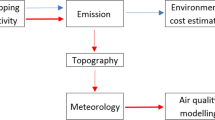Abstract
Ports can generate large quantity of pollutants in the atmosphere due to various activities like loading and unloading,transportation, and construction operations. Determination of the character and quantity of emissions from individual sources is an essential step in any project to control and minimize the emissions.In this study a detailed emission inventory of total suspendedparticulate matter (TSP), particulate matter less than 10 μm(PM10), sulfur dioxide (SO2) and nitrogen oxides (NOx) for a port and harbour project near Mumbai is compiled. Results show that the total annual average contributions of TSP and PM10 from all the port activitieswere 872 and 221 t yr-1, respectively. Annual average emissions of gaseous pollutants SO2 and NOxwere 56 and 397 t yr-1, respectively, calculatedby using emission factors for different port activities. The maximum TSP emission (419 t yr -1) was from paved roads, while the least (0.4 t yr-1) was from bulk handling activity. The maximum PM10 emission (123 t yr-1) was from unpaved roads and minimum (0.2 t yr-1) from bulk handling operations. Similarly the ratio of TSP and PM10 emission was highest (5.18) from paved roads and least (2.17) from bulk handling operations. Regression relation was derivedfrom existing emission data of TSP and PM10 from variousport activities. Good correlation was observed between TSP andPM10 having regression coefficient >0.8.
Similar content being viewed by others
References
Capaldo, K., Corbett, J. J., Kasibhatla, P., Fischbeck, P. and Pandis, S. N.: 1999, 'Effect of ship emissions on sulphur cycling and radiative climate forcing over the ocean', Nature 400, 743–746.
Chow, J. C. and Watson, J. G.: 1992, 'Fugitive emissions add to air pollution', Environ. Protect. 3, 26–31.
Chow, J. C., Watson, J. G., Ono, D. M. and Mathai, C. V.: 1993, 'PM10 standards and nontraditional particulate sources controls', A summary of the A and WMA/EPA international specialty conference, J. Air Waste Manage. Assoc. 43, 74–84.
Cowherd Jr., C. and Englehart, P. J.: 1984, Paved Road Particulate Emissions, EPA-600/7-84-077, U.S. Environmental Protection Agency, Washington, DC.
Dunbar, D. R.: 1993, 'Resuspension of Particulate Matter', EPA-450/2-76-031, Emission Factor Documentation for AP-42, Section 13.2.1 Paved Roads, EPA Contract No. 68-DO-0123, Work Assignment No. 44, MRI Project No. 9712-44.
Gaffney, P., Bode, R. and Murchison, L.: 1995, 'PM10 Emission Inventory Improvement Program for California', Report available from Patrick Gaffney, Air Resources Board, 2020 L Street, Sacramento, California, 95814.
Galloway, J. M.: 1989, 'Atmosphere acidification: Projections for the future', Ambio 18, 161–166.
Garg, A., Shukla, P. R., Bhattacharya, S. and Dadhwal, V. K.: 2001, 'Sub-region (district) and sector level SO2 and NOx emissions for India: Assessment of inventories and mitigation flexibility', Atmosph. Environ. 35, 703–713.
Gupta, N. K.: 1999, Marine Department: An Overview, Shipping and Marine Industries Journal, Vol. 22, Mumbai, India, pp. 41–43.
IPCC: 1996, 'Revised IPCC Guidelines for National Greenhouse Gas Inventories', Reference Manual, Vol. 3, Inter Governmental Panel on Climate Change, Bracknell, U.S.A.
Kato, N. and Akimoto, H.: 1992, 'Anthropogenic emissions of SO2 and NOx in Asia: Emission inventories', Atmosph. Environ. 26A(16), 2997–3017.
Kulkarni, S. M.: 1999, J N Port in the Threshold of Expansion, Shipping and Marine Industries Journal, Vol. 22, Mumbai, India, p. 69.
Lubkert, B. and De Tilly, S.: 1989, 'The OECD-MAP emission inventory for SO2, NOx and VOC in Western Europe', Atmosph. Environ. 23, 3–15.
Rodhe, H.: 1989 'Acidification in a global perspective', Ambio 18, 155–160.
Streets, D. G., Tsai, N. Y., Akimoto, H. and Oka, K.: 2000a, 'Sulfur dioxide emissions in asia in the period 1985–1997', Atmosph. Environ. 34, 4413–4424.
Streets, D. G., Guttikunda, S. K. and Carmichael, G. R.: 2000b, 'The growing contribution of sulphur emissions from ships in asian waters, 1988–1995', Atmosph. Environ. 34, 4425–4439.
Urbair: 1996, 'Urban Air Quality Management Strategy in Asia, Greater Mumbai Report', in J. S. Jitendra and N. Tanvi (eds), The World Bank, Washington DC.
U.S. Environmental Protection Agency: 1988, Compilation of Air Pollutant Emission Factors, AP-42, U.S. Environmental Protection Agency, Research Triangle Park, NC.
Veldt, C. and Bakkum, A.: 1987, 'Atmospheric Emission Inventory Project CORINAIR Emission Factors', TNO Report for the Commission of the European N Communities DG XI, CORINE, Ref. No. 87-127, 's-Gravenhage.
WHO: 1981, Rapid Assessment of Sources of Air, Water and Land Pollution, Vol. 62, WHO, Geneva.
Author information
Authors and Affiliations
Corresponding author
Rights and permissions
About this article
Cite this article
Gupta, A.K., Patil, R.S. & Gupta, S.K. Emissions of Gaseous and Particulate Pollutants in a Port and Harbour Region in India. Environ Monit Assess 80, 187–205 (2002). https://doi.org/10.1023/A:1020641014104
Issue Date:
DOI: https://doi.org/10.1023/A:1020641014104




